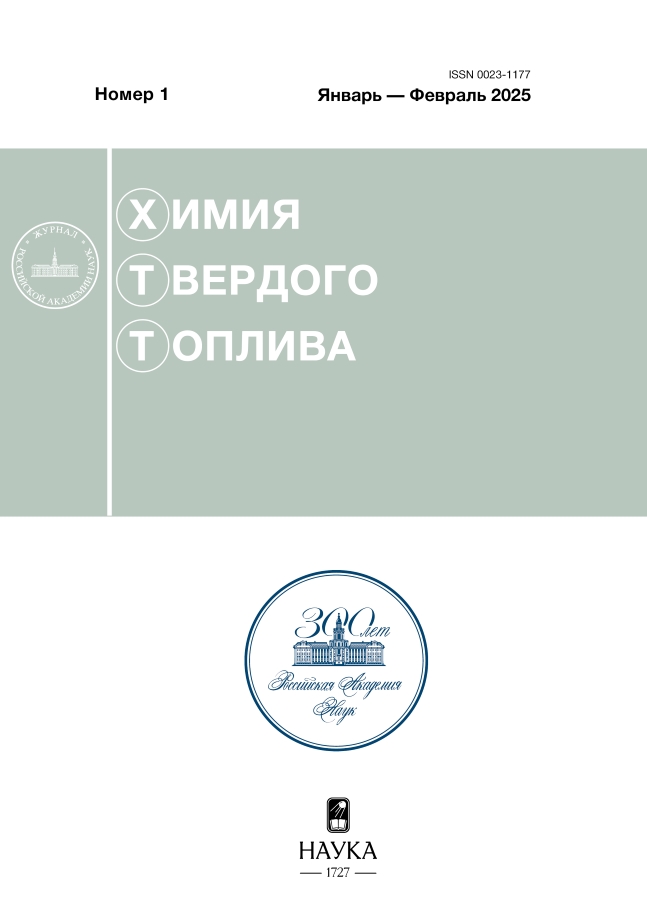Changes in the composition of polyaromatic hydrocarbons of Siberian oil shales under modeling of thermal processes
- Autores: Korol I.S.1, Mukhortina N.A.1, Chuikina D.I.1, Krasnoyarova N.A.2
-
Afiliações:
- Trofimuk Institute of Petroleum Geology and Geophysics of SB RAS
- Institute of Petroleum Chemistry SB RAS
- Edição: Nº 1 (2025)
- Páginas: 90-99
- Seção: Articles
- URL: https://kazanmedjournal.ru/0023-1177/article/view/684067
- DOI: https://doi.org/10.31857/S0023117725010123
- EDN: https://elibrary.ru/KTIHAE
- ID: 684067
Citar
Texto integral
Resumo
The results of studies of polyaromatic hydrocarbons (PAHs) in oil shales (HS) of Barzasskoye (Barzassite) and Budagovskoye (Sapropelite) deposits and their ash residues obtained by thermal degradation at T = 300, 500 and 750°C with free oxygen access are presented. The complex of physicochemical methods of analysis (extraction, infrared spectroscopy, high-performance liquid chromatography) allowed to establish the composition of priority PAHs of oil shale and trace the changes occurring under thermal influence. As a result of the performed work it is shown that the yield of ash residues of oil shale is dependent on the initial composition of HS, ranging from 5 to 82 wt % depending on the temperature of degradation. PAH content in ash residues does not exceed 9.5 wt %.
Texto integral
Sobre autores
I. Korol
Trofimuk Institute of Petroleum Geology and Geophysics of SB RAS
Autor responsável pela correspondência
Email: irinakorol@yandex.ru
Tomsk Branch
Rússia, 634055 TomskN. Mukhortina
Trofimuk Institute of Petroleum Geology and Geophysics of SB RAS
Email: volkovana@ipgg.sbras.ru
Tomsk Branch
Rússia, 634055 TomskD. Chuikina
Trofimuk Institute of Petroleum Geology and Geophysics of SB RAS
Email: dichuikina@mail.ru
Tomsk Branch
Rússia, 634055 TomskN. Krasnoyarova
Institute of Petroleum Chemistry SB RAS
Email: natalex@ipc.tsu.ru
Rússia, 634055 Tomsk
Bibliografia
- Стрижакова Ю.А. Горючие сланцы. Генезис, составы, ресурсы. М.: Недра, 2008. 192 с.
- Кузнецова Л.В., Анферов Б.А., Патраков Ю.Ф. // Известия УГГУ. 2018. Вып. 1(49). С. 62–67. https://doi.org/10.21440/2307-2091-2018-1-62-67
- Ketels C., Protsiv S. Methodology and Findings Report for a Cluster Mapping of Related Sectors. Stockholm: Stockholm School Economics, 2014. URL: http://ec.europa.eu/growth/smes/cluster/observatory/ d1.2-cluster-mapping-report.pdf
- Патраков Ю.Ф., Кузнецова Л.В., Анферов Б.А. // Вестник КузГТУ. 2016. № 4. С. 33–43.
- Ровинский Ф.Я., Теплицкая Т.А., Алексеева Т.А. Фоновый мониторинг полициклоароматических углеводородов. Л.: Гидрометеоиздат, 1988. 233 с.
- Grimmer G., Misfeld J. // Enviromental Carcinogens: Polycyclic Aromatic Hydrocardons/ Ed. G. Gimmer.-Boca Ration/ 1983. P. 1–26.
- Янин Е.П. Горючие сланцы и окружающая среда. М.: ИМГРЭ. 2003., 86 с.
- СанПиН 2.1.3684-21 “Санитарно-эпидемиологические требования к содержанию территорий городских и сельских поселений, к водным объектам, питьевой воде и питьевому водоснабжению, атмосферному воздуху, почвам, жилым помещениям, эксплуатации производственных, общественных помещений, организации и проведению санитарно-противоэпидемических (профилактических) мероприятий”
- Король И.С., Чуйкина Д.И. // Башкирский химический журнал. 2023. Т. 30. № 1. С. 123–128.
- Современные методы анализа нефтей /Под ред. Богомолова А.И., Темянко М.Б., Хотынцевой Л.И.. Л.: Недра, 1984. 432 с.
- Веселовский В.В. Испытание горючих ископаемых. М.: Госгеолиздат, 1951. 245 с.
- Цибарт А.С., Геннадиев А.Н. // Почвоведение. 2013. № 7. С. 788–802.
- Borrego A., Prado J., Fuento E., et al. // J. Anal. Appl. Pyrolysis. 2000. № 56. P. 1–16.
- Тимошина И.Д., Фомин А.Н., Конторович А.Э. // Геология нефти и газа. 2024. № 2. С . 73–86
- Геохимия полициклических ароматических углеводородов в горных породах и почвах/ Под ред. А. Н. Геннадиева и Ю.И. Пиковского. М.: Изд-во МГУ, 1996. 188 с.
- Liu G., Niu Z., Niekerk D., Xue J., Zheng L. // Rev. Environ. Contam. Toxcol. 2008. V. 192. P. 1–28
- Yan J., You X., Li X., Ni M., Yin X., Cen K. // J. of Zhejiang University. 2004. V. 5 P. 1554–1564.
- Оглоблина А.И., Пиковский Ю.И., Добрянский Л.А., Курило М.В. // Геологический журнал.1992. № 1. С. 107–115.
Arquivos suplementares














